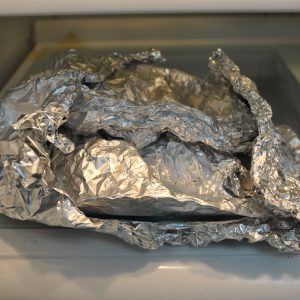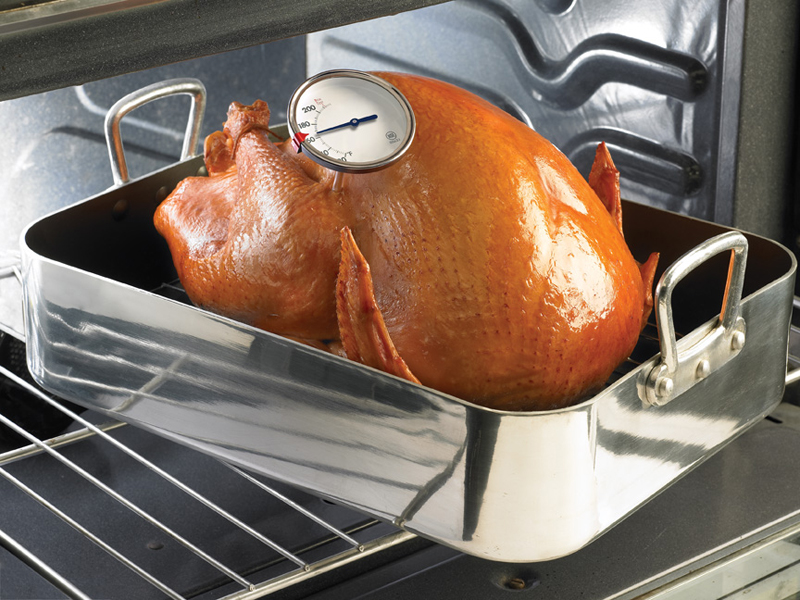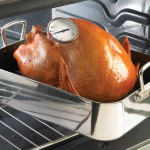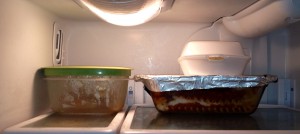
by Samantha Kennedy | Feb 28, 2019

Storing foods in aluminum foil is a not a good food safety practice since it does not form a tight enough seal to keep out air, moisture, or microorganisms. Use air-tight containers or zipper plastic bags to store leftovers safely. (Photo source: Samantha Kennedy)
This month, I would like to focus on leftovers, more specifically, using and storing leftovers responsibly.
Many times, leftovers are saved with the best intentions. We really do plan to eat last night’s lasagna for dinner tonight, but then something better comes along and suddenly that lasagna gets pushed to the back of the refrigerator where it gets forgotten until the fridge is cleaned out two months later.
That dried out, fuzzy lump covered in foil? Well, it used to be lasagna. Now it is inedible, unsafe, and a waste of food and money.
I say, stop the madness! Show those leftovers a little love. If properly stored and handled, those boring leftovers can once again dazzle your palate.
First of all, proper storage is key. Whether being put in the refrigerator or freezer, wrap or store leftovers in an air-tight container. This will not only prevent cross-contamination by microorganisms, but will also help maintain flavor and quality.
The only exception to this is whole, fresh fruits and veggies, which need to be stored in the crisper drawer or on the countertop to allow air flow. Cut fruits and veggies should always be refrigerated.
The best materials for food storage are air-tight plastic or glass containers and paper or zipper bags made for freezer use. When using paper, be sure to wrap the food tightly and completely.
Aluminum foil, wax paper, and plastic wrap do not make effective wrappers for the freezer since they do not form a tight enough seal to prevent freezer burn.
Always label all leftovers, especially when freezing them, with the name of the food and the date it was stored. To ensure safety, discard refrigerated leftovers after five days and frozen leftovers after six months. Foods frozen longer will suffer significant quality loss.
Leftover foods like soups, stews, and casseroles make terrific quick meals for lunch or dinner. Simply divide the leftovers into single portions and freeze, or refrigerate if all portions will be eaten within five days.
Foods like leftover roasted chicken or breakfast bacon can be added to a salad or made into a sandwich. Today’s leftover pancakes can be tomorrow’s pancake parfait or breakfast sandwich bread.
Leftover scrambled eggs can be added to tonight’s fried rice. Last night’s chili can be made into today’s baked potato topping.
The possibilities are endless.
“Leftovers” does not have to be a dirty word. With a little planning, knowledge, and ingenuity, leftovers can easily become a family favorite. And the best part, saving leftovers means saving money, too.
For more information on food storage tips, try these publications from UF/IFAS Extension:
Healthy Eating: Food Storage Guide
Preserving Food: Freezing Vegetables
Extension classes are open to everyone regardless of race, creed, color, religion, age, disability, sex, sexual orientation, marital status, national origin, political opinions or affiliations.

by Judy Corbus | Nov 27, 2015
 Have questions about safely preparing your holiday meal? Refer to this quick reference for answers to common questions this time of year:
Have questions about safely preparing your holiday meal? Refer to this quick reference for answers to common questions this time of year:
Q. Approximately how long should you allow for thawing a frozen turkey in the refrigerator?
A. 24 hours per each 4 – 5 pounds of turkey. In it’s original wrapper, place the frozen bird in the refrigerator (40˚F or below). To prevent cross contamination, be sure to place the turkey in a container. A thawed turkey can remain in the refrigerator for 1 – 2 days.
Q. How long should I cook the turkey?
A.
COOKING TIME – UNSTUFFED
Size of Turkey Estimated Time to Reach 165˚F
8 – 12 pounds 2 ¾ – 3 hours
12 – 14 pounds 3 – 3¾ hours
14 – 18 pounds 3 ¾ – 4 ¼ hours
18 – 20 pounds 4 ¼ – 4 ½ hours
20 – 24 pounds 4 ½ – 5 hours
COOKING TIME – STUFFED
Size of Turkey Estimated Time to Reach 165˚F
8 – 12 pounds 3 – 3 ½ hours
12 – 14 pounds 3 ½ – 4 hours
14 – 18 pounds 4 – 4 ¼ hours
18 – 20 pounds 4¼ – 4 ¾ hours
20 – 24 pounds 4 ¾ – 5 ¼ hours
Q. What is a safe internal temperature for cooking a whole turkey?
A. 165˚F. Use a food thermometer to check the internal temperature of the turkey. Insert the thermometer in the innermost part of the thigh and wing and the thickest part of the breast, making sure not to touch the bone. All turkey meat, including any that remains pink, is safe to eat as soon as all parts reach at least 165˚F. Let the turkey stand 20 minutes after removing from the oven. Remove any stuffing and carve the turkey.
Q. What is the recommended temperature for stuffing?
A. 165˚F. The stuffing should reach 165˚F whether cooked inside the bird or in a separate dish.
Q. I want to stuff the turkey. How do I do this safely?
A.
1. Cook any raw meat, poultry, or shellfish you plan to use before stuffing the turkey. Do not mix wet and dry ingredients until just before stuffing the turkey cavity; wet ingredients can be prepared ahead of time and refrigerated.
2. Spoon stuffing directly into the cavity right after preparation. Stuff loosely – plan for ¾ cup of stuffing per pound. The stuffing should be moist, not dry – bacteria is destroyed more quickly by heat in a moist environment. Do NOT stuff turkeys to be grilled, smoked, fried, or microwaved.
3. Cook the turkey immediately in an oven no lower than 325˚F.
4. Use a food thermometer to make sure the temperature of the turkey AND the center of the stuffing have reached a safe minimum internal temperature of 165˚F.
5. Let the cooked turkey rest for 20 minutes before removing the stuffing and carving.
Q. How long can I keep leftovers?
A. Refrigerate all leftovers within two hours after cooking. Divide cooked foods into shallow containers; this allows the center of the food to cool more quickly and evenly. Use within 3-4 days or freeze for longer storage. Be sure to reheat hot foods to at least 165˚F; sauces, soups, and gravies should be heated to a rolling boil.
For more information about holiday foods and food safety (in English and Spanish), call: USDA Meat and Poultry Hotline, 1-888-MPHotline (1-888-674-6854) www.fsis.usda.gov
Source: Avoid Guessing About Holiday Food Safety, University of Nebraska-Lincoln Extension.
by Ricki McWilliams | Nov 13, 2014
 There is a time limit on leftovers.
There is a time limit on leftovers.
While leftovers can be a lifesaver for figuring out lunch the next day or dinner when you’re in a time crunch, it is important to remember safe food handling practices including eating, freezing or tossing out refrigerated leftovers within 3-4 days.
Limits to leftovers
Put leftovers in the refrigerator as soon as possible; make sure your refrigerator temperature is 40o F or colder. When possible, label your leftovers with a date and eat within 4 days. If you want to enjoy your leftovers longer than 4 days, transfer them to the freezer. TIP: When placing hot foods directly in the refrigerator, separate the food into small, shallow containers. This allows the food to cool more quickly.
Storage for Leftover Foods – Best Quality
| Product |
Refrigerator (40o F) |
Freezer (0o F) |
| Eggs: |
| Casserole, quiche, omelet |
3-4 days |
2 months |
| Hard-cooked |
1 weeks |
Do not freeze |
| Soups & Stews: |
| Vegetables |
3-4 days |
2-3 months |
| Meat added |
1-2 days |
2-3 months |
| Meat Leftovers: |
| Cooked meat & meat dishes |
3-4 days |
2-3 months |
| Gravy & meat broth |
1-2 days |
2-3 months |
| Cooked Poultry |
| Fried Chicken, plain pieces, cooked poultry dishes |
3-4 days |
4 months |
| Pieces, with broth/gravy |
1-2 days |
6 months |
| Chicken nuggets, patties |
1-2 days |
1-3 months |
| Cooked Seafood: |
| Fish |
3-4 days |
3 months |
| Crab |
1-2 days |
3 months |
| Shrimp |
3-4 days |
2 months |
Fight Bacteria
Follow these four safe food handling practices to keep your foods safe from bacteria:
- Clean: Wash surfaces and hands before and after handling food products.
- Separate: Keep foods separate and don’t cross-contaminate.
- Cook: Cook and reheat food to at least 165o F (gravy, soups, and sauces should be reheated to a boil). Measure temperatures with a food thermometer.
- Chill: Bacteria grow quickly between 41o F and 140o F. Keep your food out of the danger zone by refrigerating it promptly.
For additional food safety information, contact your local UF/IFAS Extension Faculty member in your area.
Sources:
Partnership for Food Safety Education. www.fightbac.org
USDA Food Safety and Inspection Service. August 2013. Basics for Handling Food Safely. http://www.fsis.usda.gov/wps/portal/fsis/topics/food-safety-education/get-answers/food-safety-fact-sheets/safe-food-handling/basics-for-handling-food-safely/





